Given an integer array arr and a mapping function fn, return a new array with a transformation applied to each element.
The returned array should be created such that returnedArray[i] = fn(arr[i], i).
Please solve it without the built-in Array.map method.
9 |
Example 1:
10 | 11 |Input: arr = [1,2,3], fn = function plusone(n) { return n + 1; }
12 | Output: [2,3,4]
13 | Explanation:
14 | const newArray = map(arr, plusone); // [2,3,4]
15 | The function increases each value in the array by one.
16 |
17 |
18 | Example 2:
19 | 20 |Input: arr = [1,2,3], fn = function plusI(n, i) { return n + i; }
21 | Output: [1,3,5]
22 | Explanation: The function increases each value by the index it resides in.
23 |
24 |
25 | Example 3:
26 | 27 |Input: arr = [10,20,30], fn = function constant() { return 42; }
28 | Output: [42,42,42]
29 | Explanation: The function always returns 42.
30 |
31 |
32 | 33 |
Constraints:
34 | 35 |-
36 |
0 <= arr.length <= 1000
37 | -109 <= arr[i] <= 109
38 | fn returns a number
39 |
nums of 2n integers, group these integers into n pairs (a1, b1), (a2, b2), ..., (an, bn) such that the sum of min(ai, bi) for all i is maximized. Return the maximized sum.
3 |
4 | 5 |
Example 1:
6 | 7 |Input: nums = [1,4,3,2] 8 | Output: 4 9 | Explanation: All possible pairings (ignoring the ordering of elements) are: 10 | 1. (1, 4), (2, 3) -> min(1, 4) + min(2, 3) = 1 + 2 = 3 11 | 2. (1, 3), (2, 4) -> min(1, 3) + min(2, 4) = 1 + 2 = 3 12 | 3. (1, 2), (3, 4) -> min(1, 2) + min(3, 4) = 1 + 3 = 4 13 | So the maximum possible sum is 4.14 | 15 |
Example 2:
16 | 17 |Input: nums = [6,2,6,5,1,2] 18 | Output: 9 19 | Explanation: The optimal pairing is (2, 1), (2, 5), (6, 6). min(2, 1) + min(2, 5) + min(6, 6) = 1 + 2 + 6 = 9. 20 |21 | 22 |
23 |
Constraints:
24 | 25 |-
26 |
1 <= n <= 104
27 | nums.length == 2 * n
28 | -104 <= nums[i] <= 104
29 |
array.last() method on any array and it will return the last element. If there are no elements in the array, it should return -1.
3 | 4 |
Example 1:
5 | 6 |Input: nums = [1,2,3] 7 | Output: 3 8 | Explanation: Calling nums.last() should return the last element: 3. 9 |10 | 11 |
Example 2:
12 | 13 |Input: nums = [] 14 | Output: -1 15 | Explanation: Because there are no elements, return -1. 16 |17 | 18 |
19 |
Constraints:
20 | 21 |-
22 |
0 <= arr.length <= 1000
23 | 0 <= arr[i] <= 1000
24 |
Create a class ArrayWrapper that accepts an array of integers in it's constructor. This class should have two features:
-
5 |
- When two instances of this class are added together with the
+operator, the resulting value is the sum of all the elements in both arrays.
6 | - When the
String()function is called on the instance, it will return a comma separated string surrounded by brackets. For example,[1,2,3].
7 |
10 |
Example 1:
11 | 12 |Input: nums = [[1,2],[3,4]], operation = "Add" 13 | Output: 10 14 | Explanation: 15 | const obj1 = new ArrayWrapper([1,2]); 16 | const obj2 = new ArrayWrapper([3,4]); 17 | obj1 + obj2; // 10 18 |19 | 20 |
Example 2:
21 | 22 |Input: nums = [[23,98,42,70]], operation = "String" 23 | Output: "[23,98,42,70]" 24 | Explanation: 25 | const obj = new ArrayWrapper([23,98,42,70]); 26 | String(obj); // "[23,98,42,70]" 27 |28 | 29 |
Example 3:
30 | 31 |Input: nums = [[],[]], operation = "Add" 32 | Output: 0 33 | Explanation: 34 | const obj1 = new ArrayWrapper([]); 35 | const obj2 = new ArrayWrapper([]); 36 | obj1 + obj2; // 0 37 |38 | 39 |
40 |
Constraints:
41 | 42 |-
43 |
0 <= nums.length <= 1000
44 | 0 <= nums[i] <= 1000
45 | Note: nums is the array passed to the constructor
46 |
Given an array of integers nums and an integer target, return indices of the two numbers such that they add up to target.
You may assume that each input would have exactly one solution, and you may not use the same element twice.
5 | 6 |You can return the answer in any order.
7 | 8 |9 |
Example 1:
10 | 11 |Input: nums = [2,7,11,15], target = 9 12 | Output: [0,1] 13 | Explanation: Because nums[0] + nums[1] == 9, we return [0, 1]. 14 |15 | 16 |
Example 2:
17 | 18 |Input: nums = [3,2,4], target = 6 19 | Output: [1,2] 20 |21 | 22 |
Example 3:
23 | 24 |Input: nums = [3,3], target = 6 25 | Output: [0,1] 26 |27 | 28 |
29 |
Constraints:
30 | 31 |-
32 |
2 <= nums.length <= 104
33 | -109 <= nums[i] <= 109
34 | -109 <= target <= 109
35 | - Only one valid answer exists. 36 |
39 | Follow-up: Can you come up with an algorithm that is less than
O(n2) time complexity?
--------------------------------------------------------------------------------
/Array of Objects to Matrix/array-of-objects-to-matrix.cpp:
--------------------------------------------------------------------------------
1 | class Solution {
2 | public:
3 | vectorYou are given an array prices where prices[i] is the price of a given stock on the ith day.
You want to maximize your profit by choosing a single day to buy one stock and choosing a different day in the future to sell that stock.
5 | 6 |Return the maximum profit you can achieve from this transaction. If you cannot achieve any profit, return 0.
9 |
Example 1:
10 | 11 |Input: prices = [7,1,5,3,6,4] 12 | Output: 5 13 | Explanation: Buy on day 2 (price = 1) and sell on day 5 (price = 6), profit = 6-1 = 5. 14 | Note that buying on day 2 and selling on day 1 is not allowed because you must buy before you sell. 15 |16 | 17 |
Example 2:
18 | 19 |Input: prices = [7,6,4,3,1] 20 | Output: 0 21 | Explanation: In this case, no transactions are done and the max profit = 0. 22 |23 | 24 |
25 |
Constraints:
26 | 27 |-
28 |
1 <= prices.length <= 105
29 | 0 <= prices[i] <= 104
30 |
There are n bulbs that are initially off. You first turn on all the bulbs, then you turn off every second bulb.
On the third round, you toggle every third bulb (turning on if it's off or turning off if it's on). For the ith round, you toggle every i bulb. For the nth round, you only toggle the last bulb.
Return the number of bulbs that are on after n rounds.
9 |
Example 1:
10 | 11 |
11 | Input: n = 3 12 | Output: 1 13 | Explanation: At first, the three bulbs are [off, off, off]. 14 | After the first round, the three bulbs are [on, on, on]. 15 | After the second round, the three bulbs are [on, off, on]. 16 | After the third round, the three bulbs are [on, off, off]. 17 | So you should return 1 because there is only one bulb is on.18 | 19 |
Example 2:
20 | 21 |Input: n = 0 22 | Output: 0 23 |24 | 25 |
Example 3:
26 | 27 |Input: n = 1 28 | Output: 1 29 |30 | 31 |
32 |
Constraints:
33 | 34 |-
35 |
0 <= n <= 109
36 |
You have a long flowerbed in which some of the plots are planted, and some are not. However, flowers cannot be planted in adjacent plots.
3 | 4 |Given an integer array flowerbed containing 0's and 1's, where 0 means empty and 1 means not empty, and an integer n, return true if n new flowers can be planted in the flowerbed without violating the no-adjacent-flowers rule and false otherwise.
7 |
Example 1:
8 |Input: flowerbed = [1,0,0,0,1], n = 1 9 | Output: true 10 |
Example 2:
11 |Input: flowerbed = [1,0,0,0,1], n = 2 12 | Output: false 13 |14 |
15 |
Constraints:
16 | 17 |-
18 |
1 <= flowerbed.length <= 2 * 104
19 | flowerbed[i]is0or1.
20 | - There are no two adjacent flowers in
flowerbed.
21 | 0 <= n <= flowerbed.length
22 |
Write a function that checks if a given value is an instance of a given class or superclass. For this problem, an object is considered an instance of a given class if that object has access to that class's methods.
3 | 4 |There are no constraints on the data types that can be passed to the function. For example, the value or the class could be undefined.
7 |
Example 1:
8 | 9 |Input: func = () => checkIfInstanceOf(new Date(), Date) 10 | Output: true 11 | Explanation: The object returned by the Date constructor is, by definition, an instance of Date. 12 |13 | 14 |
Example 2:
15 | 16 |Input: func = () => { class Animal {}; class Dog extends Animal {}; return checkIfInstanceOf(new Dog(), Animal); }
17 | Output: true
18 | Explanation:
19 | class Animal {};
20 | class Dog extends Animal {};
21 | checkIfInstanceOf(new Dog(), Animal); // true
22 |
23 | Dog is a subclass of Animal. Therefore, a Dog object is an instance of both Dog and Animal.
24 |
25 | Example 3:
26 | 27 |Input: func = () => checkIfInstanceOf(Date, Date) 28 | Output: false 29 | Explanation: A date constructor cannot logically be an instance of itself. 30 |31 | 32 |
Example 4:
33 | 34 |Input: func = () => checkIfInstanceOf(5, Number) 35 | Output: true 36 | Explanation: 5 is a Number. Note that the "instanceof" keyword would return false. However, it is still considered an instance of Number because it accesses the Number methods. For example "toFixed()". 37 |38 | -------------------------------------------------------------------------------- /Check if Object Instance of Class/check-if-object-instance-of-class: -------------------------------------------------------------------------------- 1 | function checkIfInstanceOf(obj: any, classFunction: any): boolean { 2 | while (obj != null) { 3 | if (obj.constructor === classFunction) { 4 | return true; 5 | } 6 | 7 | obj = Object.getPrototypeOf(obj) 8 | } 9 | 10 | return false 11 | }; -------------------------------------------------------------------------------- /Check if One String Swap Can Make Strings Equal/README.md: -------------------------------------------------------------------------------- 1 | # [Check if One String Swap Can Make Strings Equal](https://leetcode.com/problems/check-if-one-string-swap-can-make-strings-equal/) 2 |
You are given two strings s1 and s2 of equal length. A string swap is an operation where you choose two indices in a string (not necessarily different) and swap the characters at these indices.
Return true if it is possible to make both strings equal by performing at most one string swap on exactly one of the strings. Otherwise, return false.
7 |
Example 1:
8 | 9 |Input: s1 = "bank", s2 = "kanb" 10 | Output: true 11 | Explanation: For example, swap the first character with the last character of s2 to make "bank". 12 |13 | 14 |
Example 2:
15 | 16 |Input: s1 = "attack", s2 = "defend" 17 | Output: false 18 | Explanation: It is impossible to make them equal with one string swap. 19 |20 | 21 |
Example 3:
22 | 23 |Input: s1 = "kelb", s2 = "kelb" 24 | Output: true 25 | Explanation: The two strings are already equal, so no string swap operation is required. 26 |27 | 28 |
29 |
Constraints:
30 | 31 |-
32 |
1 <= s1.length, s2.length <= 100
33 | s1.length == s2.length
34 | s1ands2consist of only lowercase English letters.
35 |
A pangram is a sentence where every letter of the English alphabet appears at least once.
3 | 4 |Given a string sentence containing only lowercase English letters, return true if sentence is a pangram, or false otherwise.
7 |
Example 1:
8 | 9 |Input: sentence = "thequickbrownfoxjumpsoverthelazydog" 10 | Output: true 11 | Explanation: sentence contains at least one of every letter of the English alphabet. 12 |13 | 14 |
Example 2:
15 | 16 |Input: sentence = "leetcode" 17 | Output: false 18 |19 | 20 |
21 |
Constraints:
22 | 23 |-
24 |
1 <= sentence.length <= 1000
25 | sentenceconsists of lowercase English letters.
26 |
Given two integer arrays inorder and postorder where inorder is the inorder traversal of a binary tree and postorder is the postorder traversal of the same tree, construct and return the binary tree.
5 |
Example 1:
6 |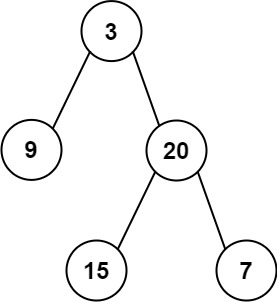 7 |
7 | Input: inorder = [9,3,15,20,7], postorder = [9,15,7,20,3] 8 | Output: [3,9,20,null,null,15,7] 9 |10 | 11 |
Example 2:
12 | 13 |Input: inorder = [-1], postorder = [-1] 14 | Output: [-1] 15 |16 | 17 |
18 |
Constraints:
19 | 20 |-
21 |
1 <= inorder.length <= 3000
22 | postorder.length == inorder.length
23 | -3000 <= inorder[i], postorder[i] <= 3000
24 | inorderandpostorderconsist of unique values.
25 | - Each value of
postorderalso appears ininorder.
26 | inorderis guaranteed to be the inorder traversal of the tree.
27 | postorderis guaranteed to be the postorder traversal of the tree.
28 |
Given an integer array nums, return true if any value appears at least twice in the array, and return false if every element is distinct.
5 |
Example 1:
6 |Input: nums = [1,2,3,1] 7 | Output: true 8 |
Example 2:
9 |Input: nums = [1,2,3,4] 10 | Output: false 11 |
Example 3:
12 |Input: nums = [1,1,1,3,3,4,3,2,4,2] 13 | Output: true 14 |15 |
16 |
Constraints:
17 | 18 |-
19 |
1 <= nums.length <= 105
20 | -109 <= nums[i] <= 109
21 |
Given an object, return a valid JSON string of that object. You may assume the object only includes strings, integers, arrays, objects, booleans, and null. The returned string should not include extra spaces. The order of keys should be the same as the order returned by Object.keys().
Please solve it without using the built-in JSON.stringify method.
7 |
Example 1:
8 | 9 |Input: object = {"y":1,"x":2}
10 | Output: {"y":1,"x":2}
11 | Explanation:
12 | Return the JSON representation.
13 | Note that the order of keys should be the same as the order returned by Object.keys().
14 |
15 | Example 2:
16 | 17 |Input: object = {"a":"str","b":-12,"c":true,"d":null}
18 | Output: {"a":"str","b":-12,"c":true,"d":null}
19 | Explanation:
20 | The primitives of JSON are strings, numbers, booleans, and null.
21 |
22 |
23 | Example 3:
24 | 25 |Input: object = {"key":{"a":1,"b":[{},null,"Hello"]}}
26 | Output: {"key":{"a":1,"b":[{},null,"Hello"]}}
27 | Explanation:
28 | Objects and arrays can include other objects and arrays.
29 |
30 |
31 | Example 4:
32 | 33 |Input: object = true 34 | Output: true 35 | Explanation: 36 | Primitive types are valid inputs.37 | 38 |
39 |
Constraints:
40 | 41 |-
42 |
object includes strings, integers, booleans, arrays, objects, and null
43 | 1 <= JSON.stringify(object).length <= 105
44 | maxNestingLevel <= 1000
45 | all strings will only contain alphanumeric characters
46 |
Given the head of a singly linked list where elements are sorted in ascending order, convert it to a
5 |
Example 1:
6 |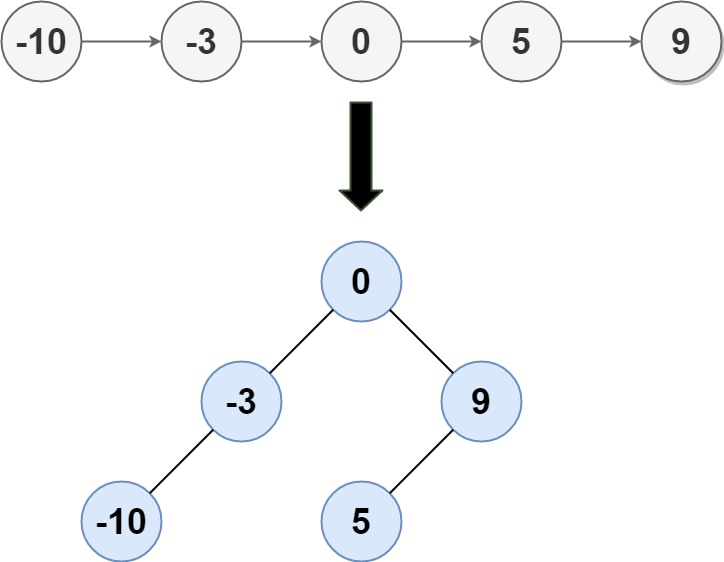 7 |
7 | Input: head = [-10,-3,0,5,9] 8 | Output: [0,-3,9,-10,null,5] 9 | Explanation: One possible answer is [0,-3,9,-10,null,5], which represents the shown height balanced BST. 10 |11 | 12 |
Example 2:
13 | 14 |Input: head = [] 15 | Output: [] 16 |17 | 18 |
19 |
Constraints:
20 | 21 |-
22 |
- The number of nodes in
headis in the range[0, 2 * 104].
23 | -105 <= Node.val <= 105
24 |
n, return the count of all numbers with unique digits, x, where 0 <= x < 10n.
3 |
4 | 5 |
Example 1:
6 | 7 |Input: n = 2 8 | Output: 91 9 | Explanation: The answer should be the total numbers in the range of 0 ≤ x < 100, excluding 11,22,33,44,55,66,77,88,99 10 |11 | 12 |
Example 2:
13 | 14 |Input: n = 0 15 | Output: 1 16 |17 | 18 |
19 |
Constraints:
20 | 21 |-
22 |
0 <= n <= 8
23 |
You are given an integer array nums and two integers minK and maxK.
A fixed-bound subarray of nums is a subarray that satisfies the following conditions:
-
7 |
- The minimum value in the subarray is equal to
minK.
8 | - The maximum value in the subarray is equal to
maxK.
9 |
Return the number of fixed-bound subarrays.
12 | 13 |A subarray is a contiguous part of an array.
14 | 15 |16 |
Example 1:
17 | 18 |Input: nums = [1,3,5,2,7,5], minK = 1, maxK = 5 19 | Output: 2 20 | Explanation: The fixed-bound subarrays are [1,3,5] and [1,3,5,2]. 21 |22 | 23 |
Example 2:
24 | 25 |Input: nums = [1,1,1,1], minK = 1, maxK = 1 26 | Output: 10 27 | Explanation: Every subarray of nums is a fixed-bound subarray. There are 10 possible subarrays. 28 |29 | 30 |
31 |
Constraints:
32 | 33 |-
34 |
2 <= nums.length <= 105
35 | 1 <= nums[i], minK, maxK <= 106
36 |
You are given an integer n. There is an undirected graph with n nodes, numbered from 0 to n - 1. You are given a 2D integer array edges where edges[i] = [ai, bi] denotes that there exists an undirected edge connecting nodes ai and bi.
Return the number of pairs of different nodes that are unreachable from each other.
5 | 6 |7 |
Example 1:
8 |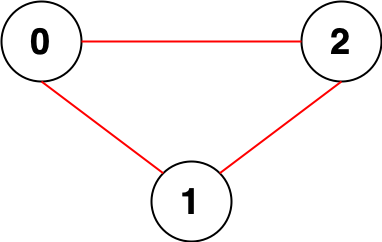 9 |
9 | Input: n = 3, edges = [[0,1],[0,2],[1,2]] 10 | Output: 0 11 | Explanation: There are no pairs of nodes that are unreachable from each other. Therefore, we return 0. 12 |13 | 14 |
Example 2:
15 |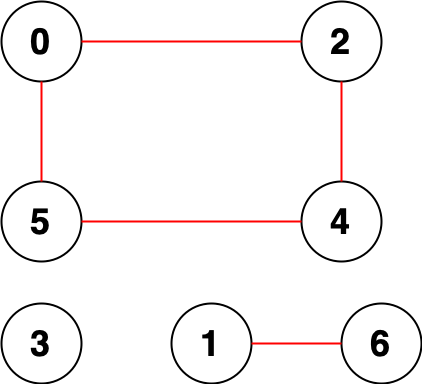 16 |
16 | Input: n = 7, edges = [[0,2],[0,5],[2,4],[1,6],[5,4]] 17 | Output: 14 18 | Explanation: There are 14 pairs of nodes that are unreachable from each other: 19 | [[0,1],[0,3],[0,6],[1,2],[1,3],[1,4],[1,5],[2,3],[2,6],[3,4],[3,5],[3,6],[4,6],[5,6]]. 20 | Therefore, we return 14. 21 |22 | 23 |
24 |
Constraints:
25 | 26 |-
27 |
1 <= n <= 105
28 | 0 <= edges.length <= 2 * 105
29 | edges[i].length == 2
30 | 0 <= ai, bi < n
31 | ai != bi
32 | - There are no repeated edges. 33 |
Given the integers zero, one, low, and high, we can construct a string by starting with an empty string, and then at each step perform either of the following:
-
5 |
- Append the character
'0'zerotimes.
6 | - Append the character
'1'onetimes.
7 |
This can be performed any number of times.
10 | 11 |A good string is a string constructed by the above process having a length between low and high (inclusive).
Return the number of different good strings that can be constructed satisfying these properties. Since the answer can be large, return it modulo 109 + 7.
16 |
Example 1:
17 | 18 |Input: low = 3, high = 3, zero = 1, one = 1 19 | Output: 8 20 | Explanation: 21 | One possible valid good string is "011". 22 | It can be constructed as follows: "" -> "0" -> "01" -> "011". 23 | All binary strings from "000" to "111" are good strings in this example. 24 |25 | 26 |
Example 2:
27 | 28 |Input: low = 2, high = 3, zero = 1, one = 2 29 | Output: 5 30 | Explanation: The good strings are "00", "11", "000", "110", and "011". 31 |32 | 33 |
34 |
Constraints:
35 | 36 |-
37 |
1 <= low <= high <= 105
38 | 1 <= zero, one <= low
39 |
Write a function createCounter. It should accept an initial integer init. It should return an object with three functions.
The three functions are:
5 | 6 |-
7 |
increment()increases the current value by 1 and then returns it.
8 | decrement()reduces the current value by 1 and then returns it.
9 | reset()sets the current value toinitand then returns it.
10 |
13 |
Example 1:
14 | 15 |Input: init = 5, calls = ["increment","reset","decrement"] 16 | Output: [6,5,4] 17 | Explanation: 18 | const counter = createCounter(5); 19 | counter.increment(); // 6 20 | counter.reset(); // 5 21 | counter.decrement(); // 4 22 |23 | 24 |
Example 2:
25 | 26 |Input: init = 0, calls = ["increment","increment","decrement","reset","reset"] 27 | Output: [1,2,1,0,0] 28 | Explanation: 29 | const counter = createCounter(0); 30 | counter.increment(); // 1 31 | counter.increment(); // 2 32 | counter.decrement(); // 1 33 | counter.reset(); // 0 34 | counter.reset(); // 0 35 |36 | 37 |
38 |
Constraints:
39 | 40 |-
41 |
-1000 <= init <= 1000
42 | total calls not to exceed 1000
43 |
Given an integer n, return a counter function. This counter function initially returns n and then returns 1 more than the previous value every subsequent time it is called (n, n + 1, n + 2, etc).
5 |
Example 1:
6 | 7 |Input: 8 | n = 10 9 | ["call","call","call"] 10 | Output: [10,11,12] 11 | Explanation: 12 | counter() = 10 // The first time counter() is called, it returns n. 13 | counter() = 11 // Returns 1 more than the previous time. 14 | counter() = 12 // Returns 1 more than the previous time. 15 |16 | 17 |
Example 2:
18 | 19 |Input: 20 | n = -2 21 | ["call","call","call","call","call"] 22 | Output: [-2,-1,0,1,2] 23 | Explanation: counter() initially returns -2. Then increases after each sebsequent call. 24 |25 | 26 |
27 |
Constraints:
28 | 29 |-
30 |
-1000 <= n <= 1000
31 | At most 1000 calls to counter() will be made
32 |
createHelloWorld. It should return a new function that always returns "Hello World".
3 | 4 |
Example 1:
5 | 6 |Input: args = [] 7 | Output: "Hello World" 8 | Explanation: 9 | const f = createHelloWorld(); 10 | f(); // "Hello World" 11 | 12 | The function returned by createHelloWorld should always return "Hello World". 13 |14 | 15 |
Example 2:
16 | 17 |Input: args = [{},null,42]
18 | Output: "Hello World"
19 | Explanation:
20 | const f = createHelloWorld();
21 | f({}, null, 42); // "Hello World"
22 |
23 | Any arguments could be passed to the function but it should still always return "Hello World".
24 |
25 |
26 | 27 |
Constraints:
28 | 29 |-
30 |
0 <= args.length <= 10
31 |
Design a data structure that supports adding new words and finding if a string matches any previously added string.
3 | 4 |Implement the WordDictionary class:
-
7 |
WordDictionary()Initializes the object.
8 | void addWord(word)Addswordto the data structure, it can be matched later.
9 | bool search(word)Returnstrueif there is any string in the data structure that matcheswordorfalseotherwise.wordmay contain dots'.'where dots can be matched with any letter.
10 |
13 |
Example:
14 | 15 |Input
16 | ["WordDictionary","addWord","addWord","addWord","search","search","search","search"]
17 | [[],["bad"],["dad"],["mad"],["pad"],["bad"],[".ad"],["b.."]]
18 | Output
19 | [null,null,null,null,false,true,true,true]
20 |
21 | Explanation
22 | WordDictionary wordDictionary = new WordDictionary();
23 | wordDictionary.addWord("bad");
24 | wordDictionary.addWord("dad");
25 | wordDictionary.addWord("mad");
26 | wordDictionary.search("pad"); // return False
27 | wordDictionary.search("bad"); // return True
28 | wordDictionary.search(".ad"); // return True
29 | wordDictionary.search("b.."); // return True
30 |
31 |
32 | 33 |
Constraints:
34 | 35 |-
36 |
1 <= word.length <= 25
37 | wordinaddWordconsists of lowercase English letters.
38 | wordinsearchconsist of'.'or lowercase English letters.
39 | - There will be at most
2dots inwordforsearchqueries.
40 | - At most
104calls will be made toaddWordandsearch.
41 |
Given two integers dividend and divisor, divide two integers without using multiplication, division, and mod operator.
The integer division should truncate toward zero, which means losing its fractional part. For example, 8.345 would be truncated to 8, and -2.7335 would be truncated to -2.
Return the quotient after dividing dividend by divisor.
Note: Assume we are dealing with an environment that could only store integers within the 32-bit signed integer range: [−231, 231 − 1]. For this problem, if the quotient is strictly greater than 231 - 1, then return 231 - 1, and if the quotient is strictly less than -231, then return -231.
11 |
Example 1:
12 | 13 |Input: dividend = 10, divisor = 3 14 | Output: 3 15 | Explanation: 10/3 = 3.33333.. which is truncated to 3. 16 |17 | 18 |
Example 2:
19 | 20 |Input: dividend = 7, divisor = -3 21 | Output: -2 22 | Explanation: 7/-3 = -2.33333.. which is truncated to -2. 23 |24 | 25 |
26 |
Constraints:
27 | 28 |-
29 |
-231 <= dividend, divisor <= 231 - 1
30 | divisor != 0
31 |
Given two strings word1 and word2, return the minimum number of operations required to convert word1 to word2.
You have the following three operations permitted on a word:
5 | 6 |-
7 |
- Insert a character 8 |
- Delete a character 9 |
- Replace a character 10 |
13 |
Example 1:
14 | 15 |Input: word1 = "horse", word2 = "ros" 16 | Output: 3 17 | Explanation: 18 | horse -> rorse (replace 'h' with 'r') 19 | rorse -> rose (remove 'r') 20 | rose -> ros (remove 'e') 21 |22 | 23 |
Example 2:
24 | 25 |Input: word1 = "intention", word2 = "execution" 26 | Output: 5 27 | Explanation: 28 | intention -> inention (remove 't') 29 | inention -> enention (replace 'i' with 'e') 30 | enention -> exention (replace 'n' with 'x') 31 | exention -> exection (replace 'n' with 'c') 32 | exection -> execution (insert 'u') 33 |34 | 35 |
36 |
Constraints:
37 | 38 |-
39 |
0 <= word1.length, word2.length <= 500
40 | word1andword2consist of lowercase English letters.
41 |
Given an integer array arr and a filtering function fn, return a new array with a fewer or equal number of elements.
The returned array should only contain elements where fn(arr[i], i) evaluated to a truthy value.
Please solve it without the built-in Array.filter method.
9 |
Example 1:
10 | 11 |Input: arr = [0,10,20,30], fn = function greaterThan10(n) { return n > 10; }
12 | Output: [20,30]
13 | Explanation:
14 | const newArray = filter(arr, fn); // [20, 30]
15 | The function filters out values that are not greater than 10
16 |
17 | Example 2:
18 | 19 |Input: arr = [1,2,3], fn = function firstIndex(n, i) { return i === 0; }
20 | Output: [1]
21 | Explanation:
22 | fn can also accept the index of each element
23 | In this case, the function removes elements not at index 0
24 |
25 |
26 | Example 3:
27 | 28 |Input: arr = [-2,-1,0,1,2], fn = function plusOne(n) { return n + 1 }
29 | Output: [-2,0,1,2]
30 | Explanation:
31 | Falsey values such as 0 should be filtered out
32 |
33 |
34 | 35 |
Constraints:
36 | 37 |-
38 |
0 <= arr.length <= 1000
39 | -109 <= arr[i] <= 109
40 |
Given two 0-indexed integer arrays nums1 and nums2, return a list answer of size 2 where:
-
5 |
answer[0]is a list of all distinct integers innums1which are not present innums2.
6 | answer[1]is a list of all distinct integers innums2which are not present innums1.
7 |
Note that the integers in the lists may be returned in any order.
10 | 11 |12 |
Example 1:
13 | 14 |Input: nums1 = [1,2,3], nums2 = [2,4,6] 15 | Output: [[1,3],[4,6]] 16 | Explanation: 17 | For nums1, nums1[1] = 2 is present at index 0 of nums2, whereas nums1[0] = 1 and nums1[2] = 3 are not present in nums2. Therefore, answer[0] = [1,3]. 18 | For nums2, nums2[0] = 2 is present at index 1 of nums1, whereas nums2[1] = 4 and nums2[2] = 6 are not present in nums2. Therefore, answer[1] = [4,6].19 | 20 |
Example 2:
21 | 22 |Input: nums1 = [1,2,3,3], nums2 = [1,1,2,2] 23 | Output: [[3],[]] 24 | Explanation: 25 | For nums1, nums1[2] and nums1[3] are not present in nums2. Since nums1[2] == nums1[3], their value is only included once and answer[0] = [3]. 26 | Every integer in nums2 is present in nums1. Therefore, answer[1] = []. 27 |28 | 29 |
30 |
Constraints:
31 | 32 |-
33 |
1 <= nums1.length, nums2.length <= 1000
34 | -1000 <= nums1[i], nums2[i] <= 1000
35 |
You are given two strings s and t.
String t is generated by random shuffling string s and then add one more letter at a random position.
Return the letter that was added to t.
9 |
Example 1:
10 | 11 |Input: s = "abcd", t = "abcde" 12 | Output: "e" 13 | Explanation: 'e' is the letter that was added. 14 |15 | 16 |
Example 2:
17 | 18 |Input: s = "", t = "y" 19 | Output: "y" 20 |21 | 22 |
23 |
Constraints:
24 | 25 |-
26 |
0 <= s.length <= 1000
27 | t.length == s.length + 1
28 | sandtconsist of lowercase English letters.
29 |
Given two strings needle and haystack, return the index of the first occurrence of needle in haystack, or -1 if needle is not part of haystack.
5 |
Example 1:
6 | 7 |Input: haystack = "sadbutsad", needle = "sad" 8 | Output: 0 9 | Explanation: "sad" occurs at index 0 and 6. 10 | The first occurrence is at index 0, so we return 0. 11 |12 | 13 |
Example 2:
14 | 15 |Input: haystack = "leetcode", needle = "leeto" 16 | Output: -1 17 | Explanation: "leeto" did not occur in "leetcode", so we return -1. 18 |19 | 20 |
21 |
Constraints:
22 | 23 |-
24 |
1 <= haystack.length, needle.length <= 104
25 | haystackandneedleconsist of only lowercase English characters.
26 |
Given an integer n, return a string array answer (1-indexed) where:
-
5 |
answer[i] == "FizzBuzz"ifiis divisible by3and5.
6 | answer[i] == "Fizz"ifiis divisible by3.
7 | answer[i] == "Buzz"ifiis divisible by5.
8 | answer[i] == i(as a string) if none of the above conditions are true.
9 |
12 |
Example 1:
13 |Input: n = 3 14 | Output: ["1","2","Fizz"] 15 |
Example 2:
16 |Input: n = 5 17 | Output: ["1","2","Fizz","4","Buzz"] 18 |
Example 3:
19 |Input: n = 15 20 | Output: ["1","2","Fizz","4","Buzz","Fizz","7","8","Fizz","Buzz","11","Fizz","13","14","FizzBuzz"] 21 |22 |
23 |
Constraints:
24 | 25 |-
26 |
1 <= n <= 104
27 |
Given the root of a binary tree, flatten the tree into a "linked list":
-
5 |
- The "linked list" should use the same
TreeNodeclass where therightchild pointer points to the next node in the list and theleftchild pointer is alwaysnull.
6 | - The "linked list" should be in the same order as a pre-order traversal of the binary tree. 7 |
10 |
Example 1:
11 |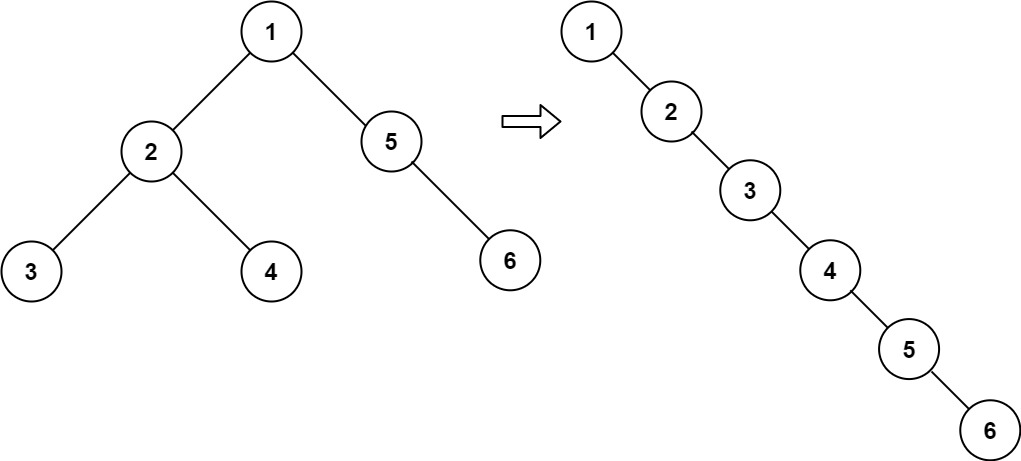 12 |
12 | Input: root = [1,2,5,3,4,null,6] 13 | Output: [1,null,2,null,3,null,4,null,5,null,6] 14 |15 | 16 |
Example 2:
17 | 18 |Input: root = [] 19 | Output: [] 20 |21 | 22 |
Example 3:
23 | 24 |Input: root = [0] 25 | Output: [0] 26 |27 | 28 |
29 |
Constraints:
30 | 31 |-
32 |
- The number of nodes in the tree is in the range
[0, 2000].
33 | -100 <= Node.val <= 100
34 |
37 | Follow up: Can you flatten the tree in-place (with
O(1) extra space)?
--------------------------------------------------------------------------------
/Flatten Binary Tree to Linked List/flatten-binary-tree-to-linked-list.py:
--------------------------------------------------------------------------------
1 | # Definition for a binary tree node.
2 | # class TreeNode:
3 | # def __init__(self, val=0, left=None, right=None):
4 | # self.val = val
5 | # self.left = left
6 | # self.right = right
7 |
8 | class Solution:
9 | def flatten(self, root: Optional[TreeNode]) -> None:
10 | """
11 | Do not return anything, modify root in-place instead.
12 | """
13 | if not root:
14 | return
15 |
16 | self.flatten(root.left)
17 | self.flatten(root.right)
18 |
19 | left = root.left
20 | right = root.right
21 |
22 | root.left = None
23 | root.right = left
24 |
25 | current = root
26 | while current.right:
27 | current = current.right
28 | current.right = right
--------------------------------------------------------------------------------
/Flatten Deeply Nested Array/flatten-deeply-nested-array:
--------------------------------------------------------------------------------
1 | var flat = function (arr, n) {
2 | return arr.flat(n);
3 | };
--------------------------------------------------------------------------------
/Function Composition/function-composition:
--------------------------------------------------------------------------------
1 | type F = (x: number) => number;
2 |
3 | function compose(functions: F[]): F {
4 | return function(x) {
5 | let funcLen = functions.length;
6 |
7 | for(let idx = funcLen-1; idx >= 0; idx--){
8 | x = functions[idx](x);
9 | }
10 |
11 | return x;
12 | }
13 | };
--------------------------------------------------------------------------------
/Generate Fibonacci Sequence/README.md:
--------------------------------------------------------------------------------
1 | # [Generate Fibonacci Sequence](https://leetcode.com/problems/generate-fibonacci-sequence/)
2 | Write a generator function that returns a generator object which yields the fibonacci sequence.
3 | 4 |The fibonacci sequence is defined by the relation Xn = Xn-1 + Xn-2.
The first few numbers of the series are 0, 1, 1, 2, 3, 5, 8, 13.
9 |
Example 1:
10 | 11 |Input: callCount = 5 12 | Output: [0,1,1,2,3] 13 | Explanation: 14 | const gen = fibGenerator(); 15 | gen.next().value; // 0 16 | gen.next().value; // 1 17 | gen.next().value; // 1 18 | gen.next().value; // 2 19 | gen.next().value; // 3 20 |21 | 22 |
Example 2:
23 | 24 |Input: callCount = 0 25 | Output: [] 26 | Explanation: gen.next() is never called so nothing is outputted 27 |28 | 29 |
30 |
Constraints:
31 | 32 |-
33 |
0 <= callCount <= 50
34 |
You own a Goal Parser that can interpret a string command. The command consists of an alphabet of "G", "()" and/or "(al)" in some order. The Goal Parser will interpret "G" as the string "G", "()" as the string "o", and "(al)" as the string "al". The interpreted strings are then concatenated in the original order.
Given the string command, return the Goal Parser's interpretation of command.
7 |
Example 1:
8 | 9 |Input: command = "G()(al)" 10 | Output: "Goal" 11 | Explanation: The Goal Parser interprets the command as follows: 12 | G -> G 13 | () -> o 14 | (al) -> al 15 | The final concatenated result is "Goal". 16 |17 | 18 |
Example 2:
19 | 20 |Input: command = "G()()()()(al)" 21 | Output: "Gooooal" 22 |23 | 24 |
Example 3:
25 | 26 |Input: command = "(al)G(al)()()G" 27 | Output: "alGalooG" 28 |29 | 30 |
31 |
Constraints:
32 | 33 |-
34 |
1 <= command.length <= 100
35 | commandconsists of"G","()", and/or"(al)"in some order.
36 |
Write an algorithm to determine if a number n is happy.
A happy number is a number defined by the following process:
5 | 6 |-
7 |
- Starting with any positive integer, replace the number by the sum of the squares of its digits. 8 |
- Repeat the process until the number equals 1 (where it will stay), or it loops endlessly in a cycle which does not include 1. 9 |
- Those numbers for which this process ends in 1 are happy. 10 |
Return true if n is a happy number, and false if not.
15 |
Example 1:
16 | 17 |Input: n = 19 18 | Output: true 19 | Explanation: 20 | 12 + 92 = 82 21 | 82 + 22 = 68 22 | 62 + 82 = 100 23 | 12 + 02 + 02 = 1 24 |25 | 26 |
Example 2:
27 | 28 |Input: n = 2 29 | Output: false 30 |31 | 32 |
33 |
Constraints:
34 | 35 |-
36 |
1 <= n <= 231 - 1
37 |
A trie (pronounced as "try") or prefix tree is a tree data structure used to efficiently store and retrieve keys in a dataset of strings. There are various applications of this data structure, such as autocomplete and spellchecker.
3 | 4 |Implement the Trie class:
5 | 6 |-
7 |
Trie()Initializes the trie object.
8 | void insert(String word)Inserts the stringwordinto the trie.
9 | boolean search(String word)Returnstrueif the stringwordis in the trie (i.e., was inserted before), andfalseotherwise.
10 | boolean startsWith(String prefix)Returnstrueif there is a previously inserted stringwordthat has the prefixprefix, andfalseotherwise.
11 |
14 |
Example 1:
15 | 16 |Input
17 | ["Trie", "insert", "search", "search", "startsWith", "insert", "search"]
18 | [[], ["apple"], ["apple"], ["app"], ["app"], ["app"], ["app"]]
19 | Output
20 | [null, null, true, false, true, null, true]
21 |
22 | Explanation
23 | Trie trie = new Trie();
24 | trie.insert("apple");
25 | trie.search("apple"); // return True
26 | trie.search("app"); // return False
27 | trie.startsWith("app"); // return True
28 | trie.insert("app");
29 | trie.search("app"); // return True
30 |
31 |
32 | 33 |
Constraints:
34 | 35 |-
36 |
1 <= word.length, prefix.length <= 2000
37 | wordandprefixconsist only of lowercase English letters.
38 | - At most
3 * 104calls in total will be made toinsert,search, andstartsWith.
39 |
Given two objects o1 and o2, check if they are deeply equal.
For two objects to be deeply equal, they must contain the same keys, and the associated values must also be deeply equal. Two objects are also considered deeply equal if they pass the === equality check.
You may assume both objects are the output of JSON.parse. In other words, they are valid JSON.
Please solve it without using lodash's _.isEqual() function.
11 |
Example 1:
12 | 13 |Input: o1 = {"x":1,"y":2}, o2 = {"x":1,"y":2}
14 | Output: true
15 | Explanation: The keys and values match exactly.
16 |
17 |
18 | Example 2:
19 | 20 |Input: o1 = {"y":2,"x":1}, o2 = {"x":1,"y":2}
21 | Output: true
22 | Explanation: Although the keys are in a different order, they still match exactly.
23 |
24 |
25 | Example 3:
26 | 27 |Input: o1 = {"x":null,"L":[1,2,3]}, o2 = {"x":null,"L":["1","2","3"]}
28 | Output: false
29 | Explanation: The array of numbers is different from the array of strings.
30 |
31 |
32 | Example 4:
33 | 34 |Input: o1 = true, o2 = false 35 | Output: false 36 | Explanation: true !== false37 | 38 |
39 |
Constraints:
40 | 41 |-
42 |
1 <= JSON.stringify(o1).length <= 105
43 | 1 <= JSON.stringify(o2).length <= 105
44 | maxNestingDepth <= 1000
45 |
Given a singly linked list, return a random node's value from the linked list. Each node must have the same probability of being chosen.
3 | 4 |Implement the Solution class:
-
7 |
Solution(ListNode head)Initializes the object with the head of the singly-linked listhead.
8 | int getRandom()Chooses a node randomly from the list and returns its value. All the nodes of the list should be equally likely to be chosen.
9 |
12 |
Example 1:
13 | 14 |
14 | Input 15 | ["Solution", "getRandom", "getRandom", "getRandom", "getRandom", "getRandom"] 16 | [[[1, 2, 3]], [], [], [], [], []] 17 | Output 18 | [null, 1, 3, 2, 2, 3] 19 | 20 | Explanation 21 | Solution solution = new Solution([1, 2, 3]); 22 | solution.getRandom(); // return 1 23 | solution.getRandom(); // return 3 24 | solution.getRandom(); // return 2 25 | solution.getRandom(); // return 2 26 | solution.getRandom(); // return 3 27 | // getRandom() should return either 1, 2, or 3 randomly. Each element should have equal probability of returning. 28 |29 | 30 |
31 |
Constraints:
32 | 33 |-
34 |
- The number of nodes in the linked list will be in the range
[1, 104].
35 | -104 <= Node.val <= 104
36 | - At most
104calls will be made togetRandom.
37 |
40 |
Follow up:
41 | 42 |-
43 |
- What if the linked list is extremely large and its length is unknown to you? 44 |
- Could you solve this efficiently without using extra space? 45 |
You are given a directed graph of n nodes numbered from 0 to n - 1, where each node has at most one outgoing edge.
The graph is represented with a given 0-indexed array edges of size n, indicating that there is a directed edge from node i to node edges[i]. If there is no outgoing edge from node i, then edges[i] == -1.
Return the length of the longest cycle in the graph. If no cycle exists, return -1.
A cycle is a path that starts and ends at the same node.
9 | 10 |11 |
Example 1:
12 |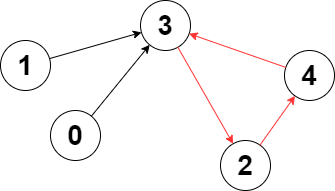 13 |
13 | Input: edges = [3,3,4,2,3] 14 | Output: 3 15 | Explanation: The longest cycle in the graph is the cycle: 2 -> 4 -> 3 -> 2. 16 | The length of this cycle is 3, so 3 is returned. 17 |18 | 19 |
Example 2:
20 |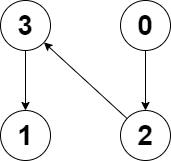 21 |
21 | Input: edges = [2,-1,3,1] 22 | Output: -1 23 | Explanation: There are no cycles in this graph. 24 |25 | 26 |
27 |
Constraints:
28 | 29 |-
30 |
n == edges.length
31 | 2 <= n <= 105
32 | -1 <= edges[i] < n
33 | edges[i] != i
34 |
Given a string s, find the longest palindromic subsequence's length in s.
A subsequence is a sequence that can be derived from another sequence by deleting some or no elements without changing the order of the remaining elements.
5 | 6 |7 |
Example 1:
8 | 9 |Input: s = "bbbab" 10 | Output: 4 11 | Explanation: One possible longest palindromic subsequence is "bbbb". 12 |13 | 14 |
Example 2:
15 | 16 |Input: s = "cbbd" 17 | Output: 2 18 | Explanation: One possible longest palindromic subsequence is "bb". 19 |20 | 21 |
22 |
Constraints:
23 | 24 |-
25 |
1 <= s.length <= 1000
26 | sconsists only of lowercase English letters.
27 |
Given a string s, return the longest s.
5 |
Example 1:
6 | 7 |Input: s = "babad" 8 | Output: "bab" 9 | Explanation: "aba" is also a valid answer. 10 |11 | 12 |
Example 2:
13 | 14 |Input: s = "cbbd" 15 | Output: "bb" 16 |17 | 18 |
19 |
Constraints:
20 | 21 |-
22 |
1 <= s.length <= 1000
23 | sconsist of only digits and English letters.
24 |
Given the root of a binary tree, return its maximum depth.
A binary tree's maximum depth is the number of nodes along the longest path from the root node down to the farthest leaf node.
5 | 6 |7 |
Example 1:
8 | 9 |
9 | Input: root = [3,9,20,null,null,15,7] 10 | Output: 3 11 |12 | 13 |
Example 2:
14 | 15 |Input: root = [1,null,2] 16 | Output: 2 17 |18 | 19 |
20 |
Constraints:
21 | 22 |-
23 |
- The number of nodes in the tree is in the range
[0, 104].
24 | -100 <= Node.val <= 100
25 |
Given a n-ary tree, find its maximum depth.
3 | 4 |The maximum depth is the number of nodes along the longest path from the root node down to the farthest leaf node.
5 | 6 |Nary-Tree input serialization is represented in their level order traversal, each group of children is separated by the null value (See examples).
7 | 8 |9 |
Example 1:
10 | 11 |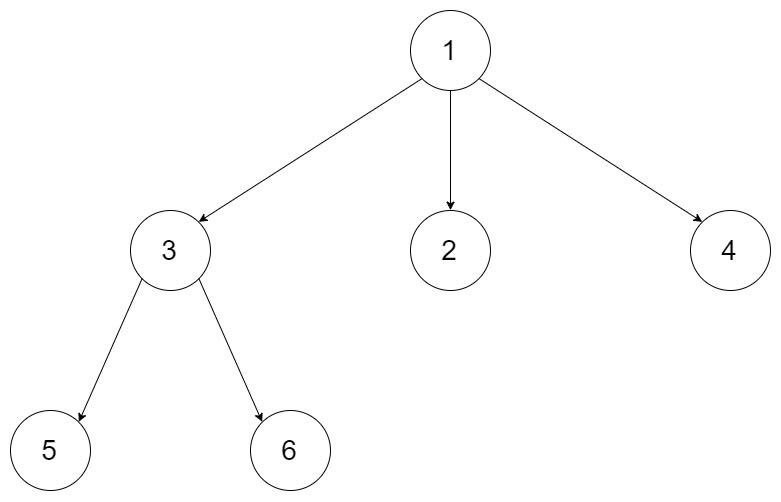
Input: root = [1,null,3,2,4,null,5,6] 14 | Output: 3 15 |16 | 17 |
Example 2:
18 | 19 |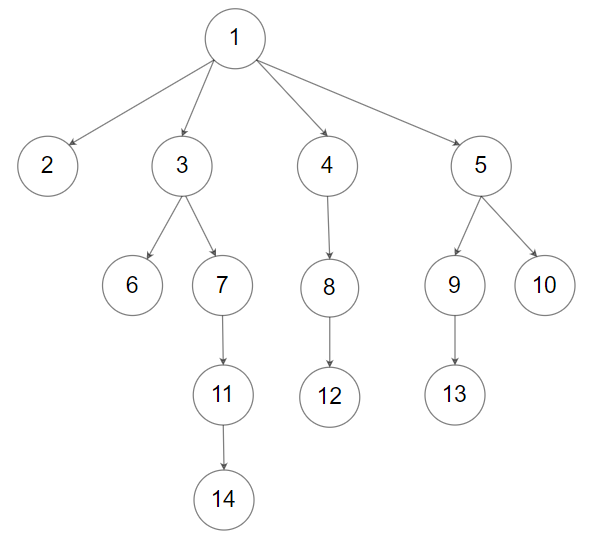
Input: root = [1,null,2,3,4,5,null,null,6,7,null,8,null,9,10,null,null,11,null,12,null,13,null,null,14] 22 | Output: 5 23 |24 | 25 |
26 |
Constraints:
27 | 28 |-
29 |
- The total number of nodes is in the range
[0, 104].
30 | - The depth of the n-ary tree is less than or equal to
1000.
31 |
There are n piles of coins on a table. Each pile consists of a positive number of coins of assorted denominations.
In one move, you can choose any coin on top of any pile, remove it, and add it to your wallet.
5 | 6 |Given a list piles, where piles[i] is a list of integers denoting the composition of the ith pile from top to bottom, and a positive integer k, return the maximum total value of coins you can have in your wallet if you choose exactly k coins optimally.
9 |
Example 1:
10 | 11 |
11 | Input: piles = [[1,100,3],[7,8,9]], k = 2 12 | Output: 101 13 | Explanation: 14 | The above diagram shows the different ways we can choose k coins. 15 | The maximum total we can obtain is 101. 16 |17 | 18 |
Example 2:
19 | 20 |Input: piles = [[100],[100],[100],[100],[100],[100],[1,1,1,1,1,1,700]], k = 7 21 | Output: 706 22 | Explanation: 23 | The maximum total can be obtained if we choose all coins from the last pile. 24 |25 | 26 |
27 |
Constraints:
28 | 29 |-
30 |
n == piles.length
31 | 1 <= n <= 1000
32 | 1 <= piles[i][j] <= 105
33 | 1 <= k <= sum(piles[i].length) <= 2000
34 |
Given two sorted arrays nums1 and nums2 of size m and n respectively, return the median of the two sorted arrays.
The overall run time complexity should be O(log (m+n)).
7 |
Example 1:
8 | 9 |Input: nums1 = [1,3], nums2 = [2] 10 | Output: 2.00000 11 | Explanation: merged array = [1,2,3] and median is 2. 12 |13 | 14 |
Example 2:
15 | 16 |Input: nums1 = [1,2], nums2 = [3,4] 17 | Output: 2.50000 18 | Explanation: merged array = [1,2,3,4] and median is (2 + 3) / 2 = 2.5. 19 |20 | 21 |
22 |
Constraints:
23 | 24 |-
25 |
nums1.length == m
26 | nums2.length == n
27 | 0 <= m <= 1000
28 | 0 <= n <= 1000
29 | 1 <= m + n <= 2000
30 | -106 <= nums1[i], nums2[i] <= 106
31 |
You are given two strings word1 and word2. Merge the strings by adding letters in alternating order, starting with word1. If a string is longer than the other, append the additional letters onto the end of the merged string.
Return the merged string.
5 | 6 |7 |
Example 1:
8 | 9 |Input: word1 = "abc", word2 = "pqr" 10 | Output: "apbqcr" 11 | Explanation: The merged string will be merged as so: 12 | word1: a b c 13 | word2: p q r 14 | merged: a p b q c r 15 |16 | 17 |
Example 2:
18 | 19 |Input: word1 = "ab", word2 = "pqrs" 20 | Output: "apbqrs" 21 | Explanation: Notice that as word2 is longer, "rs" is appended to the end. 22 | word1: a b 23 | word2: p q r s 24 | merged: a p b q r s 25 |26 | 27 |
Example 3:
28 | 29 |Input: word1 = "abcd", word2 = "pq" 30 | Output: "apbqcd" 31 | Explanation: Notice that as word1 is longer, "cd" is appended to the end. 32 | word1: a b c d 33 | word2: p q 34 | merged: a p b q c d 35 |36 | 37 |
38 |
Constraints:
39 | 40 |-
41 |
1 <= word1.length, word2.length <= 100
42 | word1andword2consist of lowercase English letters.
43 |
You are given an array of k linked-lists lists, each linked-list is sorted in ascending order.
Merge all the linked-lists into one sorted linked-list and return it.
5 | 6 |7 |
Example 1:
8 | 9 |Input: lists = [[1,4,5],[1,3,4],[2,6]] 10 | Output: [1,1,2,3,4,4,5,6] 11 | Explanation: The linked-lists are: 12 | [ 13 | 1->4->5, 14 | 1->3->4, 15 | 2->6 16 | ] 17 | merging them into one sorted list: 18 | 1->1->2->3->4->4->5->6 19 |20 | 21 |
Example 2:
22 | 23 |Input: lists = [] 24 | Output: [] 25 |26 | 27 |
Example 3:
28 | 29 |Input: lists = [[]] 30 | Output: [] 31 |32 | 33 |
34 |
Constraints:
35 | 36 |-
37 |
k == lists.length
38 | 0 <= k <= 104
39 | 0 <= lists[i].length <= 500
40 | -104 <= lists[i][j] <= 104
41 | lists[i]is sorted in ascending order.
42 | - The sum of
lists[i].lengthwill not exceed104.
43 |
You are given a 0-indexed array nums comprising of n non-negative integers.
In one operation, you must:
5 | 6 |-
7 |
- Choose an integer
isuch that1 <= i < nandnums[i] > 0.
8 | - Decrease
nums[i]by 1.
9 | - Increase
nums[i - 1]by 1.
10 |
Return the minimum possible value of the maximum integer of nums after performing any number of operations.
15 |
Example 1:
16 | 17 |Input: nums = [3,7,1,6] 18 | Output: 5 19 | Explanation: 20 | One set of optimal operations is as follows: 21 | 1. Choose i = 1, and nums becomes [4,6,1,6]. 22 | 2. Choose i = 3, and nums becomes [4,6,2,5]. 23 | 3. Choose i = 1, and nums becomes [5,5,2,5]. 24 | The maximum integer of nums is 5. It can be shown that the maximum number cannot be less than 5. 25 | Therefore, we return 5. 26 |27 | 28 |
Example 2:
29 | 30 |Input: nums = [10,1] 31 | Output: 10 32 | Explanation: 33 | It is optimal to leave nums as is, and since 10 is the maximum value, we return 10. 34 |35 | 36 |
37 |
Constraints:
38 | 39 |-
40 |
n == nums.length
41 | 2 <= n <= 105
42 | 0 <= nums[i] <= 109
43 |
You may recall that an array arr is a mountain array if and only if:
-
5 |
arr.length >= 3
6 | - There exists some index
i(0-indexed) with0 < i < arr.length - 1such that: 7 |-
8 |
arr[0] < arr[1] < ... < arr[i - 1] < arr[i]
9 | arr[i] > arr[i + 1] > ... > arr[arr.length - 1]
10 |
12 |
Given an integer array nums, return the minimum number of elements to remove to make nums a mountain array.
17 |
Example 1:
18 | 19 |Input: nums = [1,3,1] 20 | Output: 0 21 | Explanation: The array itself is a mountain array so we do not need to remove any elements. 22 |23 | 24 |
Example 2:
25 | 26 |Input: nums = [2,1,1,5,6,2,3,1] 27 | Output: 3 28 | Explanation: One solution is to remove the elements at indices 0, 1, and 5, making the array nums = [1,5,6,3,1]. 29 |30 | 31 |
32 |
Constraints:
33 | 34 |-
35 |
3 <= nums.length <= 1000
36 | 1 <= nums[i] <= 109
37 | - It is guaranteed that you can make a mountain array out of
nums.
38 |
Given a m x n grid filled with non-negative numbers, find a path from top left to bottom right, which minimizes the sum of all numbers along its path.
Note: You can only move either down or right at any point in time.
5 | 6 |7 |
Example 1:
8 |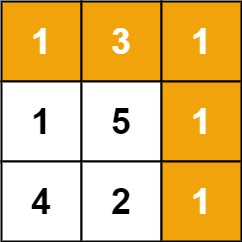 9 |
9 | Input: grid = [[1,3,1],[1,5,1],[4,2,1]] 10 | Output: 7 11 | Explanation: Because the path 1 → 3 → 1 → 1 → 1 minimizes the sum. 12 |13 | 14 |
Example 2:
15 | 16 |Input: grid = [[1,2,3],[4,5,6]] 17 | Output: 12 18 |19 | 20 |
21 |
Constraints:
22 | 23 |-
24 |
m == grid.length
25 | n == grid[i].length
26 | 1 <= m, n <= 200
27 | 0 <= grid[i][j] <= 100
28 |
You are given an array time where time[i] denotes the time taken by the ith bus to complete one trip.
Each bus can make multiple trips successively; that is, the next trip can start immediately after completing the current trip. Also, each bus operates independently; that is, the trips of one bus do not influence the trips of any other bus.
5 | 6 |You are also given an integer totalTrips, which denotes the number of trips all buses should make in total. Return the minimum time required for all buses to complete at least totalTrips trips.
9 |
Example 1:
10 | 11 |Input: time = [1,2,3], totalTrips = 5 12 | Output: 3 13 | Explanation: 14 | - At time t = 1, the number of trips completed by each bus are [1,0,0]. 15 | The total number of trips completed is 1 + 0 + 0 = 1. 16 | - At time t = 2, the number of trips completed by each bus are [2,1,0]. 17 | The total number of trips completed is 2 + 1 + 0 = 3. 18 | - At time t = 3, the number of trips completed by each bus are [3,1,1]. 19 | The total number of trips completed is 3 + 1 + 1 = 5. 20 | So the minimum time needed for all buses to complete at least 5 trips is 3. 21 |22 | 23 |
Example 2:
24 | 25 |Input: time = [2], totalTrips = 1 26 | Output: 2 27 | Explanation: 28 | There is only one bus, and it will complete its first trip at t = 2. 29 | So the minimum time needed to complete 1 trip is 2. 30 |31 | 32 |
33 |
Constraints:
34 | 35 |-
36 |
1 <= time.length <= 105
37 | 1 <= time[i], totalTrips <= 107
38 |
Given an integer array nums, move all 0's to the end of it while maintaining the relative order of the non-zero elements.
Note that you must do this in-place without making a copy of the array.
5 | 6 |7 |
Example 1:
8 |Input: nums = [0,1,0,3,12] 9 | Output: [1,3,12,0,0] 10 |
Example 2:
11 |Input: nums = [0] 12 | Output: [0] 13 |14 |
15 |
Constraints:
16 | 17 |-
18 |
1 <= nums.length <= 104
19 | -231 <= nums[i] <= 231 - 1
20 |
23 | Follow up: Could you minimize the total number of operations done? -------------------------------------------------------------------------------- /Move Zeroes/move-zeroes.py: -------------------------------------------------------------------------------- 1 | class Solution: 2 | def moveZeroes(self, nums: List[int]) -> None: 3 | """ 4 | Do not return anything, modify nums in-place instead. 5 | """ 6 | left = 0 7 | right = 0 8 | 9 | while right < len(nums): 10 | if nums[right] != 0: 11 | nums[left], nums[right] = nums[right], nums[left] 12 | left += 1 13 | right += 1 -------------------------------------------------------------------------------- /N-ary Tree Preorder Traversal/README.md: -------------------------------------------------------------------------------- 1 | # [N-ary Tree Preorder Traversal](https://leetcode.com/problems/n-ary-tree-preorder-traversal/) 2 |
Given the root of an n-ary tree, return the preorder traversal of its nodes' values.
Nary-Tree input serialization is represented in their level order traversal. Each group of children is separated by the null value (See examples)
5 | 6 |7 |
Example 1:
8 | 9 |
Input: root = [1,null,3,2,4,null,5,6] 12 | Output: [1,3,5,6,2,4] 13 |14 | 15 |
Example 2:
16 | 17 |
Input: root = [1,null,2,3,4,5,null,null,6,7,null,8,null,9,10,null,null,11,null,12,null,13,null,null,14] 20 | Output: [1,2,3,6,7,11,14,4,8,12,5,9,13,10] 21 |22 | 23 |
24 |
Constraints:
25 | 26 |-
27 |
- The number of nodes in the tree is in the range
[0, 104].
28 | 0 <= Node.val <= 104
29 | - The height of the n-ary tree is less than or equal to
1000.
30 |
33 |
Follow up: Recursive solution is trivial, could you do it iteratively?
34 | -------------------------------------------------------------------------------- /N-ary Tree Preorder Traversal/n-ary-tree-preorder-traversal.py: -------------------------------------------------------------------------------- 1 | class Solution: 2 | def preorder(self, root: 'Node') -> List[int]: 3 | ans = [] 4 | def helper(curr=root): 5 | nonlocal ans 6 | if curr: 7 | ans.append(curr.val) 8 | for i in curr.children: 9 | helper(i) 10 | helper() 11 | return ans -------------------------------------------------------------------------------- /Nested Array Generator/README.md: -------------------------------------------------------------------------------- 1 | # [Nested Array Generator](https://leetcode.com/problems/nested-array-generator/) 2 |Given a multi-dimensional array of integers, return a generator object which yields integers in the same order as inorder traversal.
3 | 4 |A multi-dimensional array is a recursive data structure that contains both integers and other multi-dimensional arrays.
5 | 6 |inorder traversal iterates over each array from left to right, yielding any integers it encounters or applying inorder traversal to any arrays it encounters.
7 | 8 |9 |
Example 1:
10 | 11 |Input: arr = [[[6]],[1,3],[]] 12 | Output: [6,1,3] 13 | Explanation: 14 | const generator = inorderTraversal(arr); 15 | generator.next().value; // 6 16 | generator.next().value; // 1 17 | generator.next().value; // 3 18 | generator.next().done; // true 19 |20 | 21 |
Example 2:
22 | 23 |Input: arr = [] 24 | Output: [] 25 | Explanation: There are no integers so the generator doesn't yield anything. 26 |27 | 28 |
29 |
Constraints:
30 | 31 |-
32 |
0 <= arr.flat().length <= 105
33 | 0 <= arr.flat()[i] <= 105
34 | maxNestingDepth <= 105
35 |
38 | Can you solve this without creating a new flattened version of the array? -------------------------------------------------------------------------------- /Nested Array Generator/nested-array-generator: -------------------------------------------------------------------------------- 1 | type MultidimensionalArray = (MultidimensionalArray | number)[] 2 | 3 | function* inorderTraversal(arr: MultidimensionalArray): Generator
Given an integer array nums, return the number of subarrays filled with 0.
A subarray is a contiguous non-empty sequence of elements within an array.
5 | 6 |7 |
Example 1:
8 | 9 |Input: nums = [1,3,0,0,2,0,0,4] 10 | Output: 6 11 | Explanation: 12 | There are 4 occurrences of [0] as a subarray. 13 | There are 2 occurrences of [0,0] as a subarray. 14 | There is no occurrence of a subarray with a size more than 2 filled with 0. Therefore, we return 6.15 | 16 |
Example 2:
17 | 18 |Input: nums = [0,0,0,2,0,0] 19 | Output: 9 20 | Explanation: 21 | There are 5 occurrences of [0] as a subarray. 22 | There are 3 occurrences of [0,0] as a subarray. 23 | There is 1 occurrence of [0,0,0] as a subarray. 24 | There is no occurrence of a subarray with a size more than 3 filled with 0. Therefore, we return 9. 25 |26 | 27 |
Example 3:
28 | 29 |Input: nums = [2,10,2019] 30 | Output: 0 31 | Explanation: There is no subarray filled with 0. Therefore, we return 0. 32 |33 | 34 |
35 |
Constraints:
36 | 37 |-
38 |
1 <= nums.length <= 105
39 | -109 <= nums[i] <= 109
40 |
Given a string s, partition the string into one or more substrings such that the characters in each substring are unique. That is, no letter appears in a single substring more than once.
Return the minimum number of substrings in such a partition.
5 | 6 |Note that each character should belong to exactly one substring in a partition.
7 | 8 |9 |
Example 1:
10 | 11 |Input: s = "abacaba"
12 | Output: 4
13 | Explanation:
14 | Two possible partitions are ("a","ba","cab","a") and ("ab","a","ca","ba").
15 | It can be shown that 4 is the minimum number of substrings needed.
16 |
17 |
18 | Example 2:
19 | 20 |Input: s = "ssssss"
21 | Output: 6
22 | Explanation:
23 | The only valid partition is ("s","s","s","s","s","s").
24 |
25 |
26 | 27 |
Constraints:
28 | 29 |-
30 |
1 <= s.length <= 105
31 | sconsists of only English lowercase letters.
32 |
Given the head of a singly linked list, return true if it is a false otherwise.
5 |
Example 1:
6 | 7 |
7 | Input: head = [1,2,2,1] 8 | Output: true 9 |10 | 11 |
Example 2:
12 | 13 |
13 | Input: head = [1,2] 14 | Output: false 15 |16 | 17 |
18 |
Constraints:
19 | 20 |-
21 |
- The number of nodes in the list is in the range
[1, 105].
22 | 0 <= Node.val <= 9
23 |
26 | Follow up: Could you do it in
O(n) time and O(1) space?
--------------------------------------------------------------------------------
/Palindrome Linked List/palindrome-linked-list.c:
--------------------------------------------------------------------------------
1 | /**
2 | * Definition for singly-linked list.
3 | * struct ListNode {
4 | * int val;
5 | * struct ListNode *next;
6 | * };
7 | */
8 |
9 |
10 | bool isPalindrome(struct ListNode* head){
11 | if(head==NULL){
12 | return true;
13 | }
14 | struct ListNode* p1=head;
15 | struct ListNode* p2=head->next;
16 | while(p2 && p2->next){
17 | p1 = p1->next;
18 | p2 = p2->next->next;
19 | }
20 |
21 | struct ListNode *prev, *curr, *n, *h2;
22 | prev = NULL;
23 | curr = p1->next;
24 | h2 = curr;
25 | while(curr){
26 | n = curr->next;
27 | curr->next = prev;
28 | prev = curr;
29 | curr = n;
30 | }
31 | p2 = head;
32 | p1 = prev;
33 | while(p1){
34 | if(p1->val!=p2->val){
35 | return false;
36 | }
37 | p1 = p1->next;
38 | p2 = p2->next;
39 | }
40 |
41 | return true;
42 |
43 | }
--------------------------------------------------------------------------------
/Problems/Readme.md:
--------------------------------------------------------------------------------
https://raw.githubusercontent.com/AdityaSeth777/LeetCode-Adi/c801e3ebb7951579aae87f7cf61f60ad28f3b22e/Problems/Readme.md
--------------------------------------------------------------------------------
/Promise Pool/promise-pool:
--------------------------------------------------------------------------------
1 | type F = () => PromiseGiven an integer array nums, handle multiple queries of the following type:
-
5 |
- Calculate the sum of the elements of
numsbetween indicesleftandrightinclusive whereleft <= right.
6 |
Implement the NumArray class:
-
11 |
NumArray(int[] nums)Initializes the object with the integer arraynums.
12 | int sumRange(int left, int right)Returns the sum of the elements ofnumsbetween indicesleftandrightinclusive (i.e.nums[left] + nums[left + 1] + ... + nums[right]).
13 |
16 |
Example 1:
17 | 18 |Input 19 | ["NumArray", "sumRange", "sumRange", "sumRange"] 20 | [[[-2, 0, 3, -5, 2, -1]], [0, 2], [2, 5], [0, 5]] 21 | Output 22 | [null, 1, -1, -3] 23 | 24 | Explanation 25 | NumArray numArray = new NumArray([-2, 0, 3, -5, 2, -1]); 26 | numArray.sumRange(0, 2); // return (-2) + 0 + 3 = 1 27 | numArray.sumRange(2, 5); // return 3 + (-5) + 2 + (-1) = -1 28 | numArray.sumRange(0, 5); // return (-2) + 0 + 3 + (-5) + 2 + (-1) = -3 29 |30 | 31 |
32 |
Constraints:
33 | 34 |-
35 |
1 <= nums.length <= 104
36 | -105 <= nums[i] <= 105
37 | 0 <= left <= right < nums.length
38 | - At most
104calls will be made tosumRange.
39 |
Given two strings ransomNote and magazine, return true if ransomNote can be constructed by using the letters from magazine and false otherwise.
Each letter in magazine can only be used once in ransomNote.
7 |
Example 1:
8 |Input: ransomNote = "a", magazine = "b" 9 | Output: false 10 |
Example 2:
11 |Input: ransomNote = "aa", magazine = "ab" 12 | Output: false 13 |
Example 3:
14 |Input: ransomNote = "aa", magazine = "aab" 15 | Output: true 16 |17 |
18 |
Constraints:
19 | 20 |-
21 |
1 <= ransomNote.length, magazine.length <= 105
22 | ransomNoteandmagazineconsist of lowercase English letters.
23 |
You are given a string s, which contains stars *.
In one operation, you can:
5 | 6 |-
7 |
- Choose a star in
s.
8 | - Remove the closest non-star character to its left, as well as remove the star itself. 9 |
Return the string after all stars have been removed.
12 | 13 |Note:
14 | 15 |-
16 |
- The input will be generated such that the operation is always possible. 17 |
- It can be shown that the resulting string will always be unique. 18 |
21 |
Example 1:
22 | 23 |Input: s = "leet**cod*e" 24 | Output: "lecoe" 25 | Explanation: Performing the removals from left to right: 26 | - The closest character to the 1st star is 't' in "leet**cod*e". s becomes "lee*cod*e". 27 | - The closest character to the 2nd star is 'e' in "lee*cod*e". s becomes "lecod*e". 28 | - The closest character to the 3rd star is 'd' in "lecod*e". s becomes "lecoe". 29 | There are no more stars, so we return "lecoe".30 | 31 |
Example 2:
32 | 33 |Input: s = "erase*****" 34 | Output: "" 35 | Explanation: The entire string is removed, so we return an empty string. 36 |37 | 38 |
39 |
Constraints:
40 | 41 |-
42 |
1 <= s.length <= 105
43 | sconsists of lowercase English letters and stars*.
44 | - The operation above can be performed on
s.
45 |
Given a string s, check if it can be constructed by taking a substring of it and appending multiple copies of the substring together.
5 |
Example 1:
6 | 7 |Input: s = "abab" 8 | Output: true 9 | Explanation: It is the substring "ab" twice. 10 |11 | 12 |
Example 2:
13 | 14 |Input: s = "aba" 15 | Output: false 16 |17 | 18 |
Example 3:
19 | 20 |Input: s = "abcabcabcabc" 21 | Output: true 22 | Explanation: It is the substring "abc" four times or the substring "abcabc" twice. 23 |24 | 25 |
26 |
Constraints:
27 | 28 |-
29 |
1 <= s.length <= 104
30 | sconsists of lowercase English letters.
31 |
In MATLAB, there is a handy function called reshape which can reshape an m x n matrix into a new one with a different size r x c keeping its original data.
You are given an m x n matrix mat and two integers r and c representing the number of rows and the number of columns of the wanted reshaped matrix.
The reshaped matrix should be filled with all the elements of the original matrix in the same row-traversing order as they were.
7 | 8 |If the reshape operation with given parameters is possible and legal, output the new reshaped matrix; Otherwise, output the original matrix.
11 |
Example 1:
12 | 13 |
13 | Input: mat = [[1,2],[3,4]], r = 1, c = 4 14 | Output: [[1,2,3,4]] 15 |16 | 17 |
Example 2:
18 | 19 |
19 | Input: mat = [[1,2],[3,4]], r = 2, c = 4 20 | Output: [[1,2],[3,4]] 21 |22 | 23 |
24 |
Constraints:
25 | 26 |-
27 |
m == mat.length
28 | n == mat[i].length
29 | 1 <= m, n <= 100
30 | -1000 <= mat[i][j] <= 1000
31 | 1 <= r, c <= 300
32 |
Given a signed 32-bit integer x, return x with its digits reversed. If reversing x causes the value to go outside the signed 32-bit integer range [-231, 231 - 1], then return 0.
Assume the environment does not allow you to store 64-bit integers (signed or unsigned).
5 | 6 |7 |
Example 1:
8 | 9 |Input: x = 123 10 | Output: 321 11 |12 | 13 |
Example 2:
14 | 15 |Input: x = -123 16 | Output: -321 17 |18 | 19 |
Example 3:
20 | 21 |Input: x = 120 22 | Output: 21 23 |24 | 25 |
26 |
Constraints:
27 | 28 |-
29 |
-231 <= x <= 231 - 1
30 |
You are given an m x n integer grid accounts where accounts[i][j] is the amount of money the ith customer has in the jth bank. Return the wealth that the richest customer has.
A customer's wealth is the amount of money they have in all their bank accounts. The richest customer is the customer that has the maximum wealth.
5 | 6 |7 |
Example 1:
8 | 9 |Input: accounts = [[1,2,3],[3,2,1]] 10 | Output: 6 11 | Explanation: 12 |16 | 17 |1st customer has wealth = 1 + 2 + 3 = 6 13 |2nd customer has wealth = 3 + 2 + 1 = 6 14 |Both customers are considered the richest with a wealth of 6 each, so return 6. 15 |
Example 2:
18 | 19 |Input: accounts = [[1,5],[7,3],[3,5]] 20 | Output: 10 21 | Explanation: 22 | 1st customer has wealth = 6 23 | 2nd customer has wealth = 10 24 | 3rd customer has wealth = 8 25 | The 2nd customer is the richest with a wealth of 10.26 | 27 |
Example 3:
28 | 29 |Input: accounts = [[2,8,7],[7,1,3],[1,9,5]] 30 | Output: 17 31 |32 | 33 |
34 |
Constraints:
35 | 36 |-
37 |
m == accounts.length
38 | n == accounts[i].length
39 | 1 <= m, n <= 50
40 | 1 <= accounts[i][j] <= 100
41 |
There is a function signFunc(x) that returns:
-
5 |
1ifxis positive.
6 | -1ifxis negative.
7 | 0ifxis equal to0.
8 |
You are given an integer array nums. Let product be the product of all values in the array nums.
Return signFunc(product).
15 |
Example 1:
16 | 17 |Input: nums = [-1,-2,-3,-4,3,2,1] 18 | Output: 1 19 | Explanation: The product of all values in the array is 144, and signFunc(144) = 1 20 |21 | 22 |
Example 2:
23 | 24 |Input: nums = [1,5,0,2,-3] 25 | Output: 0 26 | Explanation: The product of all values in the array is 0, and signFunc(0) = 0 27 |28 | 29 |
Example 3:
30 | 31 |Input: nums = [-1,1,-1,1,-1] 32 | Output: -1 33 | Explanation: The product of all values in the array is -1, and signFunc(-1) = -1 34 |35 | 36 |
37 |
Constraints:
38 | 39 |-
40 |
1 <= nums.length <= 1000
41 | -100 <= nums[i] <= 100
42 |
Given a positive integer millis, write an asynchronous function that sleeps for millis milliseconds. It can resolve any value.
5 |
Example 1:
6 | 7 |Input: millis = 100
8 | Output: 100
9 | Explanation: It should return a promise that resolves after 100ms.
10 | let t = Date.now();
11 | sleep(100).then(() => {
12 | console.log(Date.now() - t); // 100
13 | });
14 |
15 |
16 | Example 2:
17 | 18 |Input: millis = 200 19 | Output: 200 20 | Explanation: It should return a promise that resolves after 200ms. 21 |22 | 23 |
24 |
Constraints:
25 | 26 |-
27 |
1 <= millis <= 1000
28 |
Given a positive integer n, generate an n x n matrix filled with elements from 1 to n2 in spiral order.
5 |
Example 1:
6 |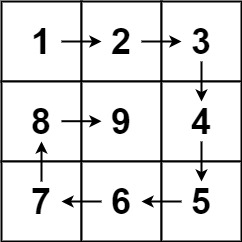 7 |
7 | Input: n = 3 8 | Output: [[1,2,3],[8,9,4],[7,6,5]] 9 |10 | 11 |
Example 2:
12 | 13 |Input: n = 1 14 | Output: [[1]] 15 |16 | 17 |
18 |
Constraints:
19 | 20 |-
21 |
1 <= n <= 20
22 |
Given an m x n matrix, return all elements of the matrix in spiral order.
5 |
Example 1:
6 |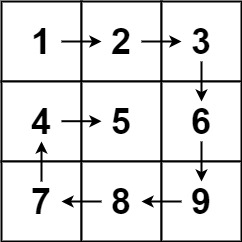 7 |
7 | Input: matrix = [[1,2,3],[4,5,6],[7,8,9]] 8 | Output: [1,2,3,6,9,8,7,4,5] 9 |10 | 11 |
Example 2:
12 | 13 |
13 | Input: matrix = [[1,2,3,4],[5,6,7,8],[9,10,11,12]] 14 | Output: [1,2,3,4,8,12,11,10,9,5,6,7] 15 |16 | 17 |
18 |
Constraints:
19 | 20 |-
21 |
m == matrix.length
22 | n == matrix[i].length
23 | 1 <= m, n <= 10
24 | -100 <= matrix[i][j] <= 100
25 |
You are given a string s representing an attendance record for a student where each character signifies whether the student was absent, late, or present on that day. The record only contains the following three characters:
-
5 |
'A': Absent.
6 | 'L': Late.
7 | 'P': Present.
8 |
The student is eligible for an attendance award if they meet both of the following criteria:
11 | 12 |-
13 |
- The student was absent (
'A') for strictly fewer than 2 days total.
14 | - The student was never late (
'L') for 3 or more consecutive days.
15 |
Return true if the student is eligible for an attendance award, or false otherwise.
20 |
Example 1:
21 | 22 |Input: s = "PPALLP" 23 | Output: true 24 | Explanation: The student has fewer than 2 absences and was never late 3 or more consecutive days. 25 |26 | 27 |
Example 2:
28 | 29 |Input: s = "PPALLL" 30 | Output: false 31 | Explanation: The student was late 3 consecutive days in the last 3 days, so is not eligible for the award. 32 |33 | 34 |
35 |
Constraints:
36 | 37 |-
38 |
1 <= s.length <= 1000
39 | s[i]is either'A','L', or'P'.
40 |
You are given the root of a binary tree containing digits from 0 to 9 only.
Each root-to-leaf path in the tree represents a number.
5 | 6 |-
7 |
- For example, the root-to-leaf path
1 -> 2 -> 3represents the number123.
8 |
Return the total sum of all root-to-leaf numbers. Test cases are generated so that the answer will fit in a 32-bit integer.
11 | 12 |A leaf node is a node with no children.
13 | 14 |15 |
Example 1:
16 |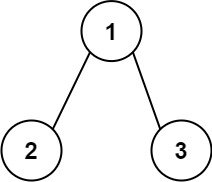 17 |
17 | Input: root = [1,2,3] 18 | Output: 25 19 | Explanation: 20 | The root-to-leaf path24 | 25 |1->2represents the number12. 21 | The root-to-leaf path1->3represents the number13. 22 | Therefore, sum = 12 + 13 =25. 23 |
Example 2:
26 |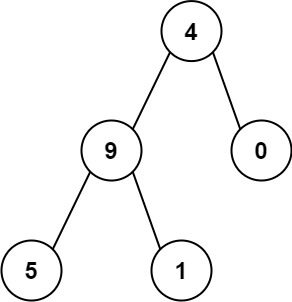 27 |
27 | Input: root = [4,9,0,5,1] 28 | Output: 1026 29 | Explanation: 30 | The root-to-leaf path35 | 36 |4->9->5represents the number 495. 31 | The root-to-leaf path4->9->1represents the number 491. 32 | The root-to-leaf path4->0represents the number 40. 33 | Therefore, sum = 495 + 491 + 40 =1026. 34 |
37 |
Constraints:
38 | 39 |-
40 |
- The number of nodes in the tree is in the range
[1, 1000].
41 | 0 <= Node.val <= 9
42 | - The depth of the tree will not exceed
10.
43 |
Given an array of positive integers arr, return the sum of all possible odd-length subarrays of arr.
A subarray is a contiguous subsequence of the array.
5 | 6 |7 |
Example 1:
8 | 9 |Input: arr = [1,4,2,5,3] 10 | Output: 58 11 | Explanation: The odd-length subarrays of arr and their sums are: 12 | [1] = 1 13 | [4] = 4 14 | [2] = 2 15 | [5] = 5 16 | [3] = 3 17 | [1,4,2] = 7 18 | [4,2,5] = 11 19 | [2,5,3] = 10 20 | [1,4,2,5,3] = 15 21 | If we add all these together we get 1 + 4 + 2 + 5 + 3 + 7 + 11 + 10 + 15 = 5822 | 23 |
Example 2:
24 | 25 |Input: arr = [1,2] 26 | Output: 3 27 | Explanation: There are only 2 subarrays of odd length, [1] and [2]. Their sum is 3.28 | 29 |
Example 3:
30 | 31 |Input: arr = [10,11,12] 32 | Output: 66 33 |34 | 35 |
36 |
Constraints:
37 | 38 |-
39 |
1 <= arr.length <= 100
40 | 1 <= arr[i] <= 1000
41 |
44 |
Follow up:
45 | 46 |Could you solve this problem in O(n) time complexity?
47 | -------------------------------------------------------------------------------- /Sum of All Odd Length Subarrays/sum-of-all-odd-length-subarrays.py: -------------------------------------------------------------------------------- 1 | class Solution: 2 | def sumOddLengthSubarrays(self, arr: List[int]) -> int: 3 | n = len(arr) 4 | result = 0 5 | 6 | for length in range(1, n+1, 2): 7 | for i in range(n-length+1): 8 | j = i + length - 1 9 | result += sum(arr[i:j+1]) 10 | 11 | return result -------------------------------------------------------------------------------- /Sum of Left Leaves/README.md: -------------------------------------------------------------------------------- 1 | # [Sum of Left Leaves](https://leetcode.com/problems/sum-of-left-leaves/) 2 |Given the root of a binary tree, return the sum of all left leaves.
A leaf is a node with no children. A left leaf is a leaf that is the left child of another node.
5 | 6 |7 |
Example 1:
8 | 9 |
9 | Input: root = [3,9,20,null,null,15,7] 10 | Output: 24 11 | Explanation: There are two left leaves in the binary tree, with values 9 and 15 respectively. 12 |13 | 14 |
Example 2:
15 | 16 |Input: root = [1] 17 | Output: 0 18 |19 | 20 |
21 |
Constraints:
22 | 23 |-
24 |
- The number of nodes in the tree is in the range
[1, 1000].
25 | -1000 <= Node.val <= 1000
26 |
Given a linked list, swap every two adjacent nodes and return its head. You must solve the problem without modifying the values in the list's nodes (i.e., only nodes themselves may be changed.)
3 | 4 |5 |
Example 1:
6 | 7 |
7 | Input: head = [1,2,3,4] 8 | Output: [2,1,4,3] 9 |10 | 11 |
Example 2:
12 | 13 |Input: head = [] 14 | Output: [] 15 |16 | 17 |
Example 3:
18 | 19 |Input: head = [1] 20 | Output: [1] 21 |22 | 23 |
24 |
Constraints:
25 | 26 |-
27 |
- The number of nodes in the list is in the range
[0, 100].
28 | 0 <= Node.val <= 100
29 |
Given the root of a binary tree, check whether it is a mirror of itself (i.e., symmetric around its center).
5 |
Example 1:
6 | 7 |
7 | Input: root = [1,2,2,3,4,4,3] 8 | Output: true 9 |10 | 11 |
Example 2:
12 | 13 |
13 | Input: root = [1,2,2,null,3,null,3] 14 | Output: false 15 |16 | 17 |
18 |
Constraints:
19 | 20 |-
21 |
- The number of nodes in the tree is in the range
[1, 1000].
22 | -100 <= Node.val <= 100
23 |
26 | Follow up: Could you solve it both recursively and iteratively? -------------------------------------------------------------------------------- /Symmetric Tree/symmetric-tree.py: -------------------------------------------------------------------------------- 1 | class Solution: 2 | def isSymmetric(self, root: Optional[TreeNode]) -> bool: 3 | if root is None: 4 | return True 5 | else: 6 | return self.isMirror(root.left, root.right) 7 | 8 | def isMirror(self, left: TreeNode, right: TreeNode) -> bool: 9 | if left is None and right is None: 10 | return True 11 | elif left is None or right is None: 12 | return False 13 | elif left.val != right.val: 14 | return False 15 | else: 16 | return self.isMirror(left.left, right.right) and self.isMirror(left.right, right.left) -------------------------------------------------------------------------------- /Throttle/throttle: -------------------------------------------------------------------------------- 1 | type F = (...args: any[]) => void 2 | 3 | function throttle(fn: F, t: number): F { 4 | let canExecute = true 5 | let cachedArgs: Parameters
Given an integer array nums and an integer k, return the k most frequent elements. You may return the answer in any order.
5 |
Example 1:
6 |Input: nums = [1,1,1,2,2,3], k = 2 7 | Output: [1,2] 8 |
Example 2:
9 |Input: nums = [1], k = 1 10 | Output: [1] 11 |12 |
13 |
Constraints:
14 | 15 |-
16 |
1 <= nums.length <= 105
17 | -104 <= nums[i] <= 104
18 | kis in the range[1, the number of unique elements in the array].
19 | - It is guaranteed that the answer is unique. 20 |
23 |
Follow up: Your algorithm's time complexity must be better than O(n log n), where n is the array's size.
Given an array of integers nums and an integer target, return indices of the two numbers such that they add up to target.
You may assume that each input would have exactly one solution, and you may not use the same element twice.
5 | 6 |You can return the answer in any order.
7 | 8 |9 |
Example 1:
10 | 11 |Input: nums = [2,7,11,15], target = 9 12 | Output: [0,1] 13 | Explanation: Because nums[0] + nums[1] == 9, we return [0, 1]. 14 |15 | 16 |
Example 2:
17 | 18 |Input: nums = [3,2,4], target = 6 19 | Output: [1,2] 20 |21 | 22 |
Example 3:
23 | 24 |Input: nums = [3,3], target = 6 25 | Output: [0,1] 26 |27 | 28 |
29 |
Constraints:
30 | 31 |-
32 |
2 <= nums.length <= 104
33 | -109 <= nums[i] <= 109
34 | -109 <= target <= 109
35 | - Only one valid answer exists. 36 |
39 | Follow-up: Can you come up with an algorithm that is less than
O(n2) time complexity?
--------------------------------------------------------------------------------
/Two Sum/two-sum.cpp:
--------------------------------------------------------------------------------
1 | class Solution {
2 | public:
3 | vectorGiven two strings s and t, return true if t is an anagram of s, and false otherwise.
An Anagram is a word or phrase formed by rearranging the letters of a different word or phrase, typically using all the original letters exactly once.
5 | 6 |7 |
Example 1:
8 |Input: s = "anagram", t = "nagaram" 9 | Output: true 10 |
Example 2:
11 |Input: s = "rat", t = "car" 12 | Output: false 13 |14 |
15 |
Constraints:
16 | 17 |-
18 |
1 <= s.length, t.length <= 5 * 104
19 | sandtconsist of lowercase English letters.
20 |
23 |
Follow up: What if the inputs contain Unicode characters? How would you adapt your solution to such a case?
24 | -------------------------------------------------------------------------------- /Valid Anagram/valid-anagram.py: -------------------------------------------------------------------------------- 1 | class Solution: 2 | def isAnagram(self, s: str, t: str) -> bool: 3 | # If the length of s and t are not equal, they cannot be anagrams 4 | if len(s) != len(t): 5 | return False 6 | 7 | # Create a dictionary to count the frequency of characters in s 8 | freq = {} 9 | for char in s: 10 | freq[char] = freq.get(char, 0) + 1 11 | 12 | # Check if the frequency of characters in t matches that of s 13 | for char in t: 14 | if char not in freq or freq[char] == 0: 15 | return False 16 | freq[char] -= 1 17 | 18 | return True -------------------------------------------------------------------------------- /Valid Parentheses/README.md: -------------------------------------------------------------------------------- 1 | # [Valid Parentheses](https://leetcode.com/problems/valid-parentheses/) 2 |Given a string s containing just the characters '(', ')', '{', '}', '[' and ']', determine if the input string is valid.
An input string is valid if:
5 | 6 |-
7 |
- Open brackets must be closed by the same type of brackets. 8 |
- Open brackets must be closed in the correct order. 9 |
- Every close bracket has a corresponding open bracket of the same type. 10 |
13 |
Example 1:
14 | 15 |Input: s = "()" 16 | Output: true 17 |18 | 19 |
Example 2:
20 | 21 |Input: s = "()[]{}"
22 | Output: true
23 |
24 |
25 | Example 3:
26 | 27 |Input: s = "(]" 28 | Output: false 29 |30 | 31 |
32 |
Constraints:
33 | 34 |-
35 |
1 <= s.length <= 104
36 | sconsists of parentheses only'()[]{}'.
37 |
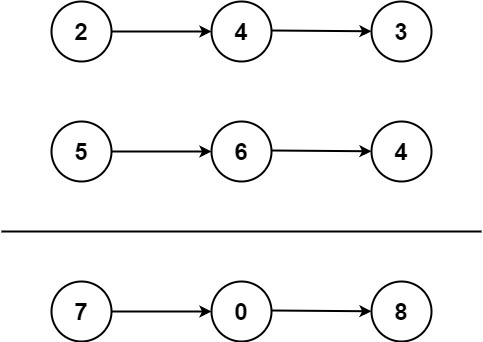 9 |
9 |